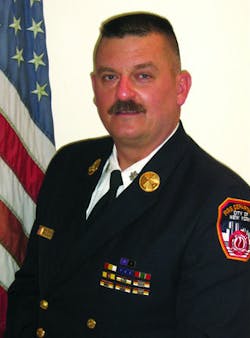The Fire Scene: Locate, Confine, Extinguish—a Simple Idea
The concept of locating, confining and then extinguishing a fire is decades old. It is a simple idea, and there is really no reason to develop an acronym to remember such basic elements of the process. While they can certainly be broken down into more specific elements, I like to focus on locate, confine and extinguish. Let’s take a look at this tried-and-true firefighting strategy.
First, locate
The first action that any fire department must take after arriving at a structural fire is to find it. This sounds pretty simple, but if you have been to even just a few fires, you know that is not always the case.
If you arrive and see smoke issuing from many windows but no visible fire, you have your work cut out for you. Maybe heavier or darker smoke from a lower-floor window will give you a hint as to the location, but you are going to have to go inside and find it. Even if there is visible fire showing from a first-floor window in a two-story house, you are going to have to enter the house to get to that room.
Seeing the fire will give you a great head start in choosing the direction or route you take to get to it. The one thing you must remember is that there are hundreds of variables at every fire. Some questions: Has the fire area already flashed over or not? How many doorways connect this room to other rooms within the house? Are the doors opened or closed? Did the fire originate in another room and extend into the room that you see the fire venting from? What is the fire load? Did the fire burn up through the floor from the basement below? Is this a gasoline-fed arson fire or an accidental electrical fire?
There are more, but the as you can see, we simply don’t have the time to collect all of these answers before going to work. Another issue that can make this first step more difficult is staffing. If you don’t have enough firefighters on scene initially to assign a search team ahead of the attack hoseline, then this function must be conducted by a team that is advancing a charged hoseline at the same time. Can you spell d-i-f-f-i-c-u-l-t?
Next, confine & extinguish
So let’s say you make a rapid entry with a hoseline into the front door of a two-story private dwelling with fire showing from a second-story window on the left side, front of the house. You quickly ascend the interior stairs to the second floor and make a left turn at the top of the stairway.
As you move closer to the room, the heat increases and the smoke condition intensifies. You can now see the door to the involved room and it is open. The fire is well developed and flames are beginning to extend into the hallway. You stop, take aim with the nozzle and begin to attack the fire. Without really knowing it, you have arrived at the spot where the burned meets the unburned, and you are literally pushing in with your attack hoseline, rotating or whipping the line back and forth and extinguishing the fire and pushing much of the smoke and heated gases and other products of combustion out the window that fire self-vented before you arrived.
If the first firefighters to enter this house were not advancing a hoseline but instead were a truck company tasked with finding the fire, they would probably take the same route to the fire area, but when they arrived, they would not have a hoseline. These firefighters would now have to confine this fire by closing the door or using a 2½-gallon pressurized water extinguisher to hold it to the room of origin. These confining tactics can play a major role in keeping the fire at bay while the engine crew gets the attack hoseline in position for extinguishment.
Now we haven’t even mentioned victims encountered or reported trapped in the house. Whether there are reports of people trapped or not, firefighters advancing inside a burning house must assume that they could encounter a victim. If a victim is discovered by the firefighters advancing a hoseline or searching without a hoseline, the victim needs to be dealt with immediately. If no victims are encountered, later-arriving crews can be assigned that task.
It’s simple!
Locate, confine and extinguish sounds so simple, doesn’t it? It sounds simple because it is simple! It’s not always easy. It’s not always fast. But it works.
About the Author
John J. Salka Jr.
Battalion Chief
JOHN J. SALKA JR., who is a Firehouse contributing editor, retired as a battalion chief with FDNY, serving as commander of the 18th battalion in the Bronx. Salka has instructed at several FDNY training programs, including the department’s Probationary Firefighters School, Captains Management Program and Battalion Chiefs Command Course. He conducts training programs at national and local conferences and has been recognized for his firefighter survival course, “Get Out Alive.” Salka co-authored the FDNY Engine Company Operations manual and wrote the book "First In, Last Out–Leadership Lessons From the New York Fire Department." He also operates Fire Command Training, which is a New York-based fire service training and consulting firm.

